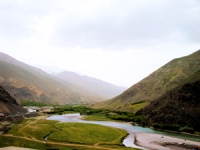Water sharing between Central Asian countries has been conflicting for quite a long time already.
The Amu Darya Basin Network, building small bridges towards larger cooperation

In the framework of its thematic priority on Capacity Building through Empowering Local Experts in the Amu Darya Basin, and under the document’s strategic goal to increase the mobility of experts of riparian countries in the basin, the EastWest Institute’s Amu Darya Basin Network facilitated a first of its kind trip of Afghan experts (from Balkh University) to the Aral Sea, the Amu Darya Delta and Khorezm, in August 2012. The trip was conducted with the leadership of Dr. Oleg Shipin of Asian Institute of Technology and Afghan members of the network (Mr Habibullah Habib and Md Qaasim – the group assists British Council’s DelPHE programme to build capacity for water protection in Northern Afghanistan through Strategic Environmental Impact Assessment).
In the second half of the 20th century, the Aral Sea, fed by the Amu Darya, became one of the world’s most significant man-made natural disasters. Post Soviet imbalances between energy and irrigation needs in Central Asia further offset the precarious desert equilibrium. On top of this, the situation was possibly exacerbated by a natural large-scale fluctuation of water resources in the region.
After decades of conflict Afghanistan increases its dependence on the Amu Darya for large-scale use of water. This group of Afghan experts visited the Aral Sea with the hope of setting the stage for a dialogue between residents of the upstream and downstream nations. Strategic water security aims to ensure that water resources are sustainable in the long run and is one of the keys to emerging long-term stability in Afghanistan. To avoid environmental collapse, a post-war Afghanistan will be in need of strategic environmental planning. This visit promotes the Strategic Environmental Assessment (SEA), which offers an effective procedure for evaluating likely adverse or positive environmental impacts of proposed development projects, plans, and policies. By identifying ways of improving project selection, planning, design and implementation, it enhances the quality and sustainability of human activities.
Strategic Environmental Assessment is impossible without accounting for the cumulative impact of human development on the environment. Excessive use of water, pollution, erosion and many other anthropogenic impacts are frequently compounding upon each other, resulting in substantial negative integrated impacts. This often leads to environmental disasters, both immediate (landslides, sandstorms, health problems, etc) and slow-onset (desertification, droughts, etc). Furthermore, climate change significantly increases the annual melting rate of glaciers in Central and North East Afghanistan, further exacerbating environmental stress. The result of the visit was a clear sense of urgency to develop strategic measures targeted at adapting to alternative water use prospects.
Quote from Dr. Oleg Shipin: Where Amu Darya ends, a debate starts. It is obvious how we all are interconnected: Afghans -upstream and Karakalpaks – downstream on Aral sea. The role which educational organizations such as Balkh University and facilitators such as the Amu Darya Basin Network, play in the complicated strategic environmental planning and management is critical. They contribute to building capacity of local experts to predict impact and plan strategically.
For more information about the trip, please contact Dr. Oleg Shipin.




